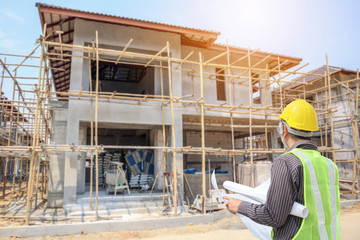Home building is a major undertaking, and it’s important to make sure you’re working with a builder that has your best interests in mind. Start by finding a top local real estate agent who can help connect you with builder options.
From laying the foundation to installing drywall, homeowners love watching their new homes take shape. Insulation is also installed, and your builder can choose from fiberglass, cellulose, and foam insulation. Click here at https://jrcsi.com/ if you’re planning to start your home project.
 Planning And Design
Planning And Design
A home is one of the largest investments a person can make in his or her lifetime. It is important to have a good understanding of the process of building a home so that you are not taken by surprise by any unexpected issues that might arise during construction.
The planning and design phase of a new home is a crucial stage in the process. This is when the architect draws up blueprints based on the client’s specifications. This is also when the architect determines if zoning laws or other restrictions on building will apply to the project. This step can save homeowners a lot of money and heartache later on.
Before you begin designing a house, it is important to understand your lifestyle and how your family uses the space in your current home. This will help you decide what features to include in the design of your new home. For example, if you often work from home, it may be wise to have a dedicated workspace with lots of electrical outlets. In addition, if you have children or are planning on caring for elderly parents in the future, these needs should be factored into your plans as well.
Once the architect has completed the design, he or she will need to have it approved by an engineer. This is to ensure that the design is up to code and structurally sound. Once the designs are finalized, the architect will prepare a set of plans for the construction team to use to build your home. These plans can be a little expensive, depending on the materials and custom features you choose, but they are necessary to bring your home to life.
While there are many great home-design software programs available, it is best to have a professional create your plan. An experienced architect will be able to draw up plans that are both beautiful and functional. It is easy to end up with a home that looks boxy and confusing or lacks natural lighting. It is also possible to design a home that doesn’t fit the property on which it will be built, which can add significantly to your costs.
Building Permits
Depending on where you live, there are several rules and regulations governing construction and renovations. Those rules are often enforced by local governments or regulatory agencies. The requirements vary by locale, but most places require anyone who performs construction on their property to have a building permit. In addition to ensuring that the work is completed safely and according to the required standards, these permits provide valuable information to government officials.
Obtaining a permit requires an initial submission of plans (like blueprints) detailing the project and its expected completion date. A licensed professional will typically draft these documents and file them with the appropriate regulators. Upon reviewing the plans and assuring that they meet building codes, authorities will authorize construction to begin. During construction, the inspector responsible for the project will regularly visit the site to ensure that the work is being done properly and that the final product meets code requirements.
In many cases, a person who performs construction without a permit can be fined. He or she may also be required to bring the finished work up to code before the property can be sold. Furthermore, if there is a serious injury to workers during construction or a structural collapse that results from the work not being up to code, the owner of the property could be held liable.
Even small projects that are affixed to existing structures can require a building permit. For example, a couple decides to convert their garage into a new living space. This involves running electrical wires, constructing drywall, and adding insulation. A permit will likely be needed for this work, even though it is not considered to be significant construction.
As part of the process of obtaining a building permit, there is usually a review of the expected durability of the final construction. This is important because the environment where a structure is located can influence its longevity. For example, areas prone to earthquakes might require all construction to be designed with a certain level of seismic resistance.
Construction
Whether you are building your new home yourself, acting as the general contractor, or hiring a company to build it for you, it is important to know the steps that are involved in this complex and rewarding process. This knowledge can help you avoid any surprises and ensure that the home you are creating is exactly what you want it to be.
The first step in building a home is the planning and design phase. This is where architects and draftspeople create the building plans for your new home based on your specifications. Your builder will also use this time to secure all necessary construction permits and finalize your home’s estimated costs.
You will typically find that the cost to build a home varies by location, with city-versus-rural costs differing considerably. Other factors include the type of construction materials, building codes, and the complexity of your home. It is essential to compare quotes from builders in your area before making a decision. Builders can range from locally-owned operations to major national corporations, so take the time to research their track records and compare prices. It’s also a good idea to drive around neighborhoods that interest you, talk with homeowners, and review homeowner’s association rules and costs.
Before you begin construction, be sure to set aside funds for concurrent expenses, like housing during the period of construction. You can usually expect to spend $90,000 on average for a 2,000-square-foot home, not including the price of your land or any utility systems you will need to install, such as water lines and a sewage system.
Once your building plans are finalized, your builder will start work on the foundation of your home. This is a crucial stage in your home’s construction, as it will determine the structural integrity of the structure. Once the foundation is in place, your builder will then frame the walls and erect any stairs or other significant portions of the house.
Depending on the size of your new home, it may require several stages of framing to complete the skeleton of your house. Once the skeleton is in place, your builder will then put up sheathing and install your roof shingles. During this stage, you will also be able to choose your plumbing fixtures and rough electrical wiring.
Finishing
This is where your home begins to take shape. The framing is in place and what was once an empty foundation will start to look like something that has a purpose. At this point, mechanical contractors will run electrical and plumbing pipes. Drywall contractors will hang drywall for the walls and ceilings of your new home, and carpenters will install the key features of your home (like interior doors).
Production home builders spend a lot of time making sure that they’re building houses that people want to buy. They pay attention to consumer surveys, hire mystery shoppers, and comb over economic and demographic data to ensure that the homes they build will sell.
When you’re building a custom home, the only way to make sure that your house doesn’t end up taking an eternity to complete is by having a detailed schedule and staying on top of change orders. One or two is no big deal, but more than that could bust your budget and delay the completion of your dream home. That’s why it’s important to have a top-notch buyer’s agent on your side who will be your liaison with the builder from start to finish. Without one, you’re on your own.

